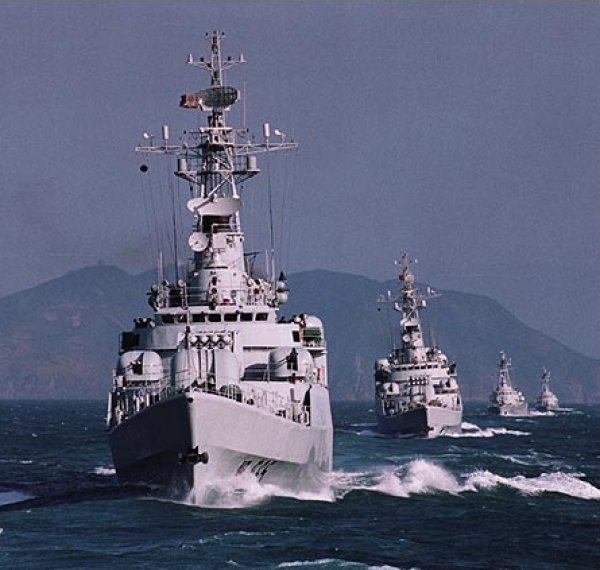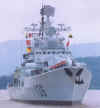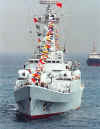|


| The Navy has for some time been at the forefront of China's
drive to be regarded as a force to be reckoned with both regionally and
internationally. The primary theatre of naval operations and the scenario
most likely to drive naval procurement is clearly the South and East China
Seas, the Yellow Sea and the Sea of Japan. This is enclosed by what is
described by China watchers as `the first island chain' that stretches
from Japan in the north to the Indonesian archipelago in the south.
Political interest is of course another matter and it is significant that
China has chosen to use naval forces, so far by modest deployments to
Australia, South Africa and across the Pacific to the United States, to
emphasise its position as a world power. Taking into account delivery of
newly acquired ships from Russia to China via the Atlantic and Indian
Oceans, it could be argued that the Chinese Navy set foot in every ocean
during the year 2000. While growing credentials as a `blue water navy'
cannot yet be interpreted as a capability to project power over oceanic
distances, it is nevertheless a marked achievement for what was a `brown
water' navy only a decade ago. There has been considerable debate about
the ability of China to invade Taiwan. Principal speculation has centered
on ballistic missile attack and follow-up operations by a sizeable, if
ageing, amphibious force, augmented by civilian sealift. Flying in support
of these forces would be an extensive inventory of land-based air defence
and ground attack aircraft, whose radius of operation from the mainland
would be augmented by in-flight refuelling. |
| At sea, a force of ships of growing sophistication provides
both offensive and defensive capabilities. The `Luhu' and larger
derivative `Luhai' are examples of indigenous build destroyers while the
acquisition of up to four Russian `Sovremenny' class, the second of which
arrived in China in February 2001, are powerful additions to the fleet as
well as being significant transfers of technology. There are in addition
some 50 more lightly armed destroyers and frigates. All this adds up to a
formidable force but any threat reduction process would also take note of
a relatively unsophisticated command, control and communications
infrastructure and low numbers of reconnaissance and airborne early
warning aircraft. All these make important contributions to the potency of
a force at sea and are essential ingredients if overall effectiveness is
to exceed the sum of its parts. |
 |
 |
While much attention has centered on Chinese surface and air
forces, rather less attention has been given to Chinese submarines and the
alternative, and some would argue more likely, scenario of a blockade of
Taiwan. That there are five current submarine programmes emphasises the
importance that China places on this form of warfare and that the
submarine's potential to act as a coercive influence is well recognised.
Five nuclear-powered attack submarines are at the forefront of the force
but the majority of boats are diesel-powered and include a mixture of
relatively modern Russian `Kilo' class and indigenous `Song' and `Ming'
classes with some thirty older Russian `Romeo' class. |
| Finally, by 2006, PLAN could get an entire fleet of
comparatively advanced diesel-electric submarines: three to four Song,
four old-generation Kilos, eight new-generation Kilos, and at least four
Chinese-made Kilos of the new version. Such a fleet, united with the
aforementioned advanced destroyers, could greatly affect the naval balance
not only around Taiwan, but in the South China Sea and East China Sea as
well. In the first half of 2002, the attention of Western military
specialists was drawn to two large-scale contracts concluded by China and
Russia and aimed at PLA (People's Liberation Army) Navy modernization: 1.
construction of two Sovremenny-class missile destroyers, for $1.4 billion;
2. construction of eight upgraded Kilo-class diesel-electric submarines,
for $1.6 billion.
Indeed, $3 billion in six months is a huge sum of money. However, this
represents only a part of the resources directed at PLA Navy (PLAN)
modernization. In any case, the rate of PLAN modernization and
construction is not inferior to similar rates of the PLA Air Force and
air-defense network. |
PLAN ( People's Liberation Army Navy ) Fleet :
Surface Combatants :
- Type 052B DDG


|
The Type 052 DDG is a new class of Guided Missile Destroyers
developed by the PLAN and could include for the first time in the PLAN a
true fleet Air-Defense capability. Armament may include the indigenously
developed HHQ-9 Air-Defense Missile System in a ship-borne vertical launch
variant. Also 2 x 30 mm 7 barrel CIWS of project 730, one at the front,
one at the back. Capable of 4600-5800 rounds/min. The new DDG could also
have a new 3D phased array radar. The Type 052B could be powered by
DA80/DN80 gas turbines imported from the Ukraine.
Stealth features are included in the design of the ship. According to
report 3 Hulls of the 052B have been laid down at Jiangnan Shipyard in
Shanghai, with the first ship being launched in May 2002 and the second
one in late 2002. A larger type of the 052B, the O51C is also planned. |
- Haizhou (Sovremenny) Class Destroyer
|


|
In 1996 an $800m deal was reached to purchase two Sovremenny
class destroyers from Russia which were initially built for Soviet
Navy each equipped with eight supersonic 3M-80E Moskit SS-N-22 SUNBURN
(75/155nm range sea-skimming) and two SA-N-7 launchers. Construction of
these two ships for the Russian navy had been suspended in 1995, with the
one ship about two-thirds complete, and the other about one-third
complete. As of August 1999 the two Sovremenyy-class destroyers ordered by
China had been launched and were expected to enter PLA-Navy service by
2002. The displacement of this class exceeds that of any other Chinese
surface warship by roughly at least 50%, indicative of the overall
improvement in combat potential.
In 2002, China announced it would purchase two more Russian-made
Sovremenny-class destroyers. The purchase for the People's Liberation Army
Navy (PLAN) adds to the two operational Sovremenny destroyers, the
Hangzhou and the Fuzhou. Unlike the Hangzhou and Fuzhou, which were
assembled on hulls laid before the fall of the Soviet Union, the two
destroyers will be new warships. According to Russia's Interfax agency
(June 28), the Severnaya Verf (Northern Wharf) shipyard in Petersburg
began building the first of two Sovremenny 956EM Project destroyers for
China in June 2002. E and M in the project designation stand for
"export" and "modernized." Construction of the second
destroyer should start at the end of July. The two destroyers are to be
completed and delivered to the customer in early 2006. the 956EM
destroyers will be much more advanced than the 956E ones; the 'M' means a
lot here. According to Western experts, these destroyers – according to
their design, at least – are the naval vessels of the 21st century.
|
- Luhai Class Destroyer


|
The largest combatant constructed in China, the Type-054
"Luhai" class destroyer entered service with the PLAN in early
1999. Overall, the ship is an enlarged version of the Luhu class, with
substantially simplified structures and masts for radar signature reduction
, equipped with 16 C801/802 SSMs, an 8-cell HQ-7 SAM launcher, and two
Z-9A helicoptors. The first Type 051B Luhai was equiped with only the
short-range HHQ-7 SAM, prompting speculation that the next generation DDG
(Type 052B?) would have an improved fleet-wide air-defense capability. The
configuration of the ship indicates that a vertical launch system [VLS]
will eventually installed
New Rice Shield/Type 381C 3D air search radar and Type 360S air/surface
search radar were also installed. Its weapon systems are not much
different from those onboard Luhu, including 16 YJ-82/YJ-83 SSM. The
onboard ECM, electro-optical sensors and C3I systems appear to
be generally similar to those installed on Luhu. However an improved
combat data system is believed to be installed. One notable difference
from the previous Luhu-class is the replacement of the
diesel-gas-turbines with gas-turbine engines.
|
- Luhu Class destroyer
 |
The Luhu-class missile destroyers are one of the most
sophisticated Chinese-built surface combatants in the PLA Navy, but are
still obsolete by Western standards. The were also the first truly
multi-role Chinese warships. Its primary surface-to-surface weapons are 8
YJ-81/YJ-82 sea-skimming SSM. Its air-defence systems include 32 Thomson-CSF
Sea Crotale/HHQ-7 SAMs and 4 twin 37mm Type 76A/715 automatic AA guns (760rd/min),
The Luhu-class air-defence systems lack a fleet defence capability beyond
visual range.
Among the western equipments on the Luhu class is the Thomson-CSF
TSR 3004 Sea Tiger Air/Surface search radars, and French-made guns. The
Thomson-CSF TAVITAC 2000 combat data system compiles a picture of the
tactical situation using inputs from radars and other sensors both on the
ship and from remote sources.The first of the class started sea trial in
late 1992 with the second in mid-1995. The third and fourth were
delayed/cancelled because of problems obtaining more LM2500 gas-turbines
and other key Western systems.
|
- Luda Class Destroyer
 |
The Type 051 Luda-class guided missile destroyer are
similar to the discontinued Soviet Kotlin class. Intended for anti-ship
strikes and were the first destroyers to be designed and built in China. The primary offensive armament is pair of "Sea Eagle I"
ship-to-ship missiles.In common with the Soviet Kotlin class, the Luda
class ships originally had no SAM missiles for self-protection. Three
major variants have been produced, with at least 16 and as many as 17
units were built between 1972 and 1991.T
Luda I initial basic
configuratuion, though with considerable variations in armament and
electronics among units. Luda II added the 8-cell HQ-7 SAM system
along with a helicopter deck and hangar replacing the aft gun armament Luda
III features improved sonars, SSMs, and electronics on a single ship,
DD166 Zhuhai.
|
- Jiangwei Class Frigate


|
The F22T Jiangwei class was the first Chinese patrol
combatant to have anti-submarine capability. This new class entered
service in 1992 and so far at least 4 vessels have been built.Its major
weapons system is the CY-1 anti-submarine missile. There is a helicopter
deck for one helicopter, and six C-802 anti-ship missiles are deployed,
though the units lack any real ASW capability.Three years after the launch
of the last Jiangwei [542 Tongling], Hudong Shipyard started
construction of the improved Jiangwei II in 1996. The new Type 057
Jiangwei-II are generally similar to the original Jiangwei in size and
arrangement.
They have upgraded radar and fire control systems, a pair of quadruple
YJ-8II SSM systems (compared to the original pair of triple launchers),
and an octuple HQ-7 SAM system. Despite these major improvements over
existing ships, they lack vertical-launch system air defense missiles,
which places them in a vulnerable position. At least five Type 057
frigates were constructed at Hudong Shipyard. The Jiangwei-III Type 059
class frigates, expected to begin construction before 2005, is anticipated
to remedy the anti-air deficiencies of the Type 055 class through the
addition of a vertical launch system battery of surface-to-air missiles.
|
- Jianghu Class Frigate


|
The Jianghu class frigate is the older generation of
frigates currently serving in large numbers with the PLAN. It is armed
with older generation surface-to-surface missiles, and an array of
manually-controlled guns. Torpedoes, ASW mortars and ASW helicopter give
the Jianghu class a certain degree of ASW capability. Its major drawback
is the lack of a medium to long range surface-to-air capability, or a CIWS
capable of defense against incoming missiles.
The early variants of this small, obsolete frigate are now primarily
useful for coastal patrol, given the absence of gunfire control radars and
obsolete missiles. The first four units of the 'Jianghu' class were laid
down in 1973 and the Chinese navy now operates 26 of them. There are three
main versions: the 'Jianghu IIs' have a hangar and carry a helicopter 'Jianghu
IIIs' have twin 100-mm gun turrets instead of single weapons. 'Jianghu
Is' have no fire-control radar. Their SSMs are the Chinese copy of
the elderly Soviet 'Styx'.
|
- Houjian Class Missile Boats
 |
The Houjian class is the latest example of a new series of
small, fast and leathal missile boats now entering service.It houses a
long-range search radar and a very capable fire control system, allowing
it to carry up to six C-801 or C-802 surface-to-surface missiles. A
compliment of guns provide limited anti-aircraft capability, but are more
suited for smaller scale encounters which do not require the use of
missiles. |
- Houxin Class Missile Boats
 |
The design of the Houxin is in line with traditional missile
boats in service with the PLAN, fitted with a heavily load of
surface-to-surface missiles and anti-aircraft guns. A compliment of four
C-801 SSMs, which outperforms the Hsiung Feng I SSM in terms of range and
warhead. As of early 2001 a total of 14 units of this class had been
completed since 1990, with production continuing at about three per year. |
- Huangfeng-class Missile Boats
 |
The Huangfeng-class missile boats are Chinese copies
of the popular Soviet Osa-I missile boat. Armed with the SS-N-2
Styx, the Osa and Komar missile boats have been staples of
most Third World navies. |
Submarines :
- Type 094


|
A new design (type 094) has been planned since the late
1980s. Possibly incorporating some Russian technology, the Type 094 is
expected to be a dramatic improvement over the sole Xia class SSBN. by
2006, China could get one or, more probably, two "094 project"
strategic submarines, equipped with JL (Julang or Giant Wave)-2
submarine-launched ballistic missiles (SLBMs) with a range of 10,000 km;
this is a submarine-based variety of China's DF-31 ICBM. Several
successful tests of these SLBMs.
by 2006, China could get one or, more probably, two "094
project" strategic submarines, equipped with JL (Julang or Giant
Wave)-2 submarine-launched ballistic missiles (SLBMs) with a range of
10,000 km; this is a submarine-based variety of China's DF-31 ICBM.
Several successful tests of these SLBMs |
- Type 093
 |
The new Type 93 SSN is expected to be similar in performance
to Russian second generation designs such as the Victor III. In summer
2001, one or two newly constructed "093 project" attack
submarines participated in Dongshan maneuvers near the coast of Fujian
province, about 200 km from Taiwan.
By 2006, PLAN could acquire at least four "093 project"
submarines, equipped by anti-ship cruise missiles with a range of up to
500 km (somewhat similar to Russia's Granit anti-ship missiles) and
land-attack cruise missiles (LACMs) with a range of up to 2,500 km
(similar to Russia's Granat LACMs). |
- Xia Class SSBN (1)
 |
In 1981 China launched the Xia-class SSBN #406, derived from
the Han-class SSN, with the hull lengthened to accommodate the missile
tubes. The Type-092 became operational in 1983, though missile firings
conducted in 1984 and 1985 were unsatisfactory due to fire control
problems which were not resoloved until until 1988.
The Xia class SSBN was initially armed with 12 JL-1 (CSS-N-3) SLBMs.
Operations have been limited and the Xia has never sailed beyond Chinese
regional waters.Somewhat surprisingly, the Xia was sighted during PLAN
exercises in December 2000. This is the first time the Xia had been
sighted at sea since it was upgraded in 1995. The single Xia class SSBN
was back into the sea after a 3-year long refit. This modernization
project included a new black paint, a new bow mounted sonar, a redesigned
casing housing longer missile launch tubes, plus upgraded combat control
systems for launching new SLBMs.
|
- Han Class SSN attack submarine (5)
 |
Work started on the Type 09-1 Han class nuclear powered
attack submarine in the late 1950s, though the first unit was not
completed until 1974. With a fully loaded displacement of 5000 tons, this
class is armed with six 533mm torpedoe tubes. The last three boats of the
class were erroneously reported to have been lengthened by eight meters to
accommodate tubes for six YJ-1 SSM launchers to the rear of the sail. All
five units of this class are deployed with the North Sea Fleet. |
- Kilo Class SSK Submarine (4)
- Song Class SSK Submarine
 |
This new class of SSG was launched in May 1994 but not
commissioned until 1998. Although it still retains the stepped conning
tower similar to the old Ming/Romeo class, the overall design represents a
major step forward compared with the obsolete Ming class. The improvement
includes a hydrodynamically sleek profile, new cylindrical bow mounted
sonars and German MTU 12V 493 diesel engine. 3 to 4 Song Class submarines
may have been built.
As in the case in the aerospace industry, China will not be giving up
the Song-class conventional submarine-upgrading project. The first two
stages of the upgrade work have been completed. Starting with the third
vessel, the Song (Type 039) submarine is very close to the French Agosta
90B in external shape. The height of the sail has been lowered in order to
increase stability underwater. It is equipped with a new weapon control
system. Song and Kilo 636 will also form a type of high-low combination.
|
Amphibious Ships:
- Yuting Class Landing Ships (6)


|
The Yuting class, although smaller in size and capacity, is
a newer, faster and more versatile design than previous landing ships. Its
cargo capacity includes the ability to carry a hovercraft for landings.
However, its relatively weak armament is intended for light defense only.
The ships do not contain a CIWS to defend against incoming missiles |
- Yukan Class Landing Ships (7)
 |
It is the largest LST in the PLAN inventory. It features
guns for light defense and fire support but lacks a CIWS system to defend
against the advanced weapons in use today.The Yukan-class large landing
ships were built to replace the elderly Landing Ship Tank vessles that
have been reduced to dockside mooring. |
Aircraft of the PLANAF ( People's Liberation Army Navy Air Force ) :
- Y-8MB


|
The modified version of the Y-8 is specifically designated
for maritime patrol.. It has a modified radome under the nose specially
enlarged to house a Litton APS-504(V)3 search radar. Other inertial and
radio navigation systems from Litton and Collins can also be found in the
aircraft. It may be fitted with air-launched variants of the C-801/802
missiles, as the PLAN prefers offensive ability, although this has not
been confirmed. |
- Z-9
 |
The Z-9 is the Chinese licensed version of the French SA-365
Dauphine 2. It is fitted with an unspecified surface search radar. It is
also expected to carry a dipping sonar and sonobuoys, possibly of a
European design. It is capable of carrying up to two Italian Whitehead
torpedos for ASW mission. A number of Z-9s are serving aboard the new
generation of frigates and destroyers. |
- Z-8
 |
The Z-8A has been fitted with a surface search radar and can
carry one torpedo. Unconfirmed reports indicate the possibility of the
type carrying an air-launched anti-ship missile. The ASW capability of the
Z-8A is relatively weak, and the PLAN is slowing replacing this type with
Z-9D ASW helicopters. |
- KA-28
 |
According to a Janes report, China is to buy 12 Kamov Ka-28
'Helix-A' twin-turbine multi-purpose helicopters from Russia to
substantially boost its anti-submarine warfare capabilities.
PLAN acquired two Ka-28 ASW helicopters in 1997 for evaluation
purpose. Later it received four ASW version and four SAR version in 1999.
An independent Ka-28 regiment was then established by the Naval
Aviation in order to train new pilots to fly the helicopter.
|
- JH-7 Fighter Bomber


|
Xian Aircraft Industry Company , based in Shaanxi Province,
produced the new JH-7 Jianhong-7 supersonic fighter- bombers for the
Chinese Navy at the modest rate of two aircraft per month, according to
some reports as few as a dozen and probably no more than two dozen]
pre-production JH-7s are in service with PLA Naval Aviation, with
additional JH-7 production awaiting the availability of a Chinese engine.
Its standard mission is anti-ship, where it carries 2 (up to 4) YJ-8
ASMs under the wing plus two wingtip PL-5B AAMs and a twin 23mm cannon
(200 rounds) for self-defense. It can also carry rocket pods or up to 20
250kg free-fall bombs for ground attack mission. it has become the first
dedicated maritime attack aircraft for PLA Naval Aviation.
|
Sources :
Visit the Site's Forum ''World's
Armed Forces Forum''
| The pictures and text displayed
on this site have been found by me on the Internet or given to me by
visitors. If these are copyrighted, let me
know and I will remove them.
|
|